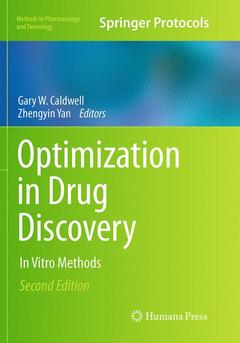Description
Optimization in Drug Discovery (2nd Ed., Softcover reprint of the original 2nd ed. 2014)
In Vitro Methods
Methods in Pharmacology and Toxicology Series
Coordinators: Caldwell Gary W., Yan Zhengyin
Language: English
Subjects for Optimization in Drug Discovery:
Publication date: 08-2016
Support: Print on demand
Publication date: 11-2013
597 p. · 17.8x25.4 cm · Hardback
Description
/li>Contents
/li>Comment
/li>
Thoroughly revised and updated, Optimization in Drug Discovery: In Vitro Methods, Second Edition presents a wide spectrum of in vitro assays including formulation, plasma binding, absorption and permeability, cytochrome P450 (CYP) and UDP-glucuronosyltransferases (UGT) metabolism, CYP inhibition and induction, drug transporters, drug-drug interactions via assessment of reactive metabolites, genotoxicity, and chemical and photo-mutagenicity assays. Written for the Methods in Pharmacology and Toxicology series, chapters include introductions to their respective topics, lists of the necessary materials and reagents, step-by-step, readily reproducible protocols, and tips on troubleshooting and avoiding known pitfalls. Expert authors have developed and utilized these in vitro assays to achieve ?drug-like? characteristics in addition to efficacy properties and good safety profiles of drug candidates.
Comprehensive and up-to-date, Optimization in Drug Discovery: In Vitro Methods, Second Edition aims to guide researchers down the difficult path to successful drug discovery and development.
Small Molecule Formulation Screening Strategies in Drug Discovery.- Assessment of Drug Plasma Protein Binding in Drug Discovery.- Drug Partition in Red Blood Cells.- Permeability Assessment Using 5-Day Cultured Caco-2 Cell Monolayers.- In Situ Single Pass Perfused Rat Intestinal Model.- Metabolic Stability Assessed by Liver Microsomes and Hepatocytes.- Metabolic Assessment in Alamethicin-Activated Liver Microsomes: Co-Activating CYPs and UGTs.- Phenotyping UDP-Glucuronosyltransferases (UGTs) Involved in Human Drug Metabolism: An Update.- In Vitro CYP/FMO Reaction Phenotyping.- Human Pregnane X Receptor (hPXR) Activation Assay in Stable Cell Lines.- Characterization of Constitutive Androstane Receptor (CAR) Activation.- DNA Binding (Gel Retardation Assay) Analysis for Identification of Aryl Hydrocarbon (Ah) Receptor Agonists and Antagonists.- Cell-Based Assays for Identification of Aryl Hydrocarbon Receptor (AhR) Activators.- In Vitro CYP Induction Using Human Hepatocytes.- Assessment of CYP3A4 Time-Dependent Inhibition in Plated and Suspended Human Hepatocytes.- Evaluation of Time-Dependent CYP3A4 Inhibition Using Human Hepatocytes.- Rapidly Distinguishing Reversible and Time-Dependent CYP450 Inhibition Using Human Liver Microsomes, Co-Incubation, and Continuous Fluorometric Kinetic Analyses.- Identification of Time-Dependent CYP Inhibitors Using Human Liver Microsomes (HLM).- CYP Time-Dependent Inhibition (TDI) Using an IC50 Shift Assay with Stable Isotopic Labeled Substrate Probes to Facilitate Liquid Chromatography/Mass Spectrometry Analyses.- Screening for P-Glycoprotein (Pgp) Substrates and Inhibitors.- In Vitro Characterization of Intestinal Transporter, Breast Cancer Resistance Protein (BCRP).- In Vitro Characterization of Intestinal and Hepatic Transporters: MRP2.- In Vitro Characterization of Hepatic Transporters OATP1B1 and OATP1B3.- In Vitro Characterization of Renal Transporters OAT1, OAT3, and OCT2.- General Guidelines for Setting Upan In Vitro LC/MS/MS Assay.- Metabolite Identification in Drug Discovery.- Drug, Lipid, and Acylcarnitine Profiling Using Dried Blood Spot (DBS) Technology in Drug Discovery.- In Vitro Trapping and Screening of Reactive Metabolites Using Liquid Chromatography-Mass Spectrometry.- Quantitative Assessment of Reactive Metabolites.- In Vitro Assessment of the Reactivity of Acyl Glucuronides.- In Vitro COMET Assay for Testing Genotoxicity of Chemicals.- Assessing DNA Damage Using a Reporter Gene System.- Improved AMES Test for Genotoxicity Assessment of Drugs: Preincubation Assay Using a Low Concentration of Dimethyl Sulfoxide.- Methods for Using the Mouse Lymphoma Assay to Screen for Chemical Mutagenicity and Photo-Mutagenicity.

